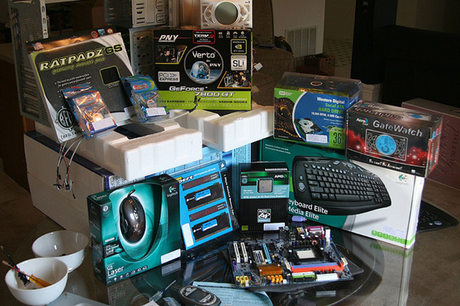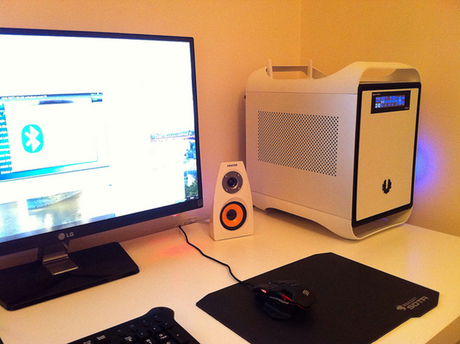Many people assume that games consoles like the Sony PlayStation 4 are the gadgets they should buy to play the latest games. But gaming PCs offer better performance and graphics than their console counterparts.
The beauty of gaming PCs is that you can upgrade any or all components to next-generation models. Whereas with games consoles, you can’t upgrade any of the core hardware that they come with. It’s for those reasons that gaming PCs are popular with a growing army of gamers.

Image Credit: garrette (Flickr)
If you are a regular PC user, you might have considered building a gaming PC. But if you’re not sure what to get or how to build it, this ultimate gaming PC guide is for you! Keep reading to learn how to build a decent gaming rig.
Intel or AMD?
When you build any PC, you first have to decide whether to opt for an Intel or AMD-based system. These two companies are the main CPU and chipset brands for today’s PC market.
Many gamers favor Intel for compatibility and reliability reasons. But, as you might imagine, there is a price premium with Intel kit. AMD-based systems offer better value for money and are just as good as Intel systems.
On a personal note, I stick with Intel whenever I build new PCs. But just because that is my preference doesn’t mean it needs to be yours too! If you’re undecided, I recommend checking out some CPU benchmarks to find out which option is best for you.
How many cores?
As many as your budget allows! Most gaming PCs use quad-core processors, such as the Intel Core i5 and Core i7 CPUs. There are CPUs with more cores, but they are all aimed at those doing graphic design work or 3D modeling rather than gaming.
Again, check out CPU benchmarks to determine which processor you should get for your budget. Whatever CPU you buy, make sure that the motherboard you get uses the same architecture.
Storage
Gaming PCs aren’t that different to conventional models. The only difference is that they use high-end components. With a gaming PC, you need to consider what your storage needs will be.
Most of today’s graphic-intensive games consume several gigabytes of disk space. The performance of the games you play will also depend on what storage mediums you use in your gaming PC.
I recommend buying a solid-state drive (SSD) to use as your main boot and operating system drive. Prices of SSDs have come down in recent months, and it is possible to pick up a cheap 256 GB SSD for less than $100.
You will also need to think about where your saved game data will go. For this purpose, buy a 2 TB or bigger hard drive. Steam lets you set which drive will be your ‘game data’ drive. That’s pretty handy, so you don’t have to worry about running out of space on your SSD!
When you connect your drives to the motherboard, make sure that the SSD goes to the SATA 3 port. By doing this, you will take advantage of the faster read and write speeds your SSD has to offer.
The port you use isn’t so much of a big deal with conventional hard drives because they can only read and write at up to 120 MB/s. The SATA 2 standard supports up to 300 MB/s, while SATA 3 is 600 MB/s – in case you wondered!
It goes without saying that you should only use brand new SSDs and hard drives in your gaming PC. The latter is quite important, as mechanical hard drives only have a limited life.

Image Credit: mogwai_83 (Flickr)
RAM
Some folks overlook the RAM they need for their gaming PCs! RAM is the “working memory” of a computer. Unlike with hard drives and SSDs, RAM is only used for storing temporary data.
DDR3 SDRAM, for instance, can transfer data up to 17 gigabytes per second. As you can imagine, it’s quicker for games to store small amounts of data in RAM that get used more often than on hard drives or SSDs!
When building a gaming rig, it’s always best to buy RAM with the highest clock speeds that your motherboard will support. In my gaming PC, I use DDR3 1600 RAM. It is possible to buy motherboards that support DDR4 RAM, but most people still use DDR3 because of price and availability.
Graphics cards
One of the most important parts of any gaming PC is the graphics card. They feature their own RAM (GDDR) and in some cases you can use a pair of graphics cards in unison for extra power and video outputs.
Today’s modern graphic cards use PCI-e x16 slots. Make sure the motherboard you buy allows for the use of two cards. The graphics cards you buy should have DVI and HDMI connectors at the back. That way, you have the flexibility of using either cable standard with your displays.
Power supply
Whatever you do, please don’t buy cheap $15 power supplies for your gaming rig! You should be looking at quality brands (Corsair, for example). And, if possible, ones that are 80+ certified. That means they are at least 80% efficient.
PC power supplies come in a range of sizes, measured in watts. Check out the chillblast.com website for examples of the PSUs they use in their gaming rigs. The good news is that decent PSUs from popular brands come with good warranties.
You are not likely to use them, but it’s good to know the support is there in case you somehow end up frying your PSU one day!
Motherboard
The board you choose should support the CPU you want to use. Today’s motherboards come with all sorts of features. I recommend choosing one that offers plenty of PCIe slots, 4x RAM slots, SATA 3 and Gigabit Ethernet.
Case
The last thing to consider for your gaming rig shopping list is the case. It needs to be big enough to allow all your parts to fit inside. It should also have at least three internal cooling and exhaust fans.
Some gamers prefer to use water cooling on their CPUs. If you decide to go down this route, make sure it allows for the provision for the pipes and radiator.
Share on Tumblr